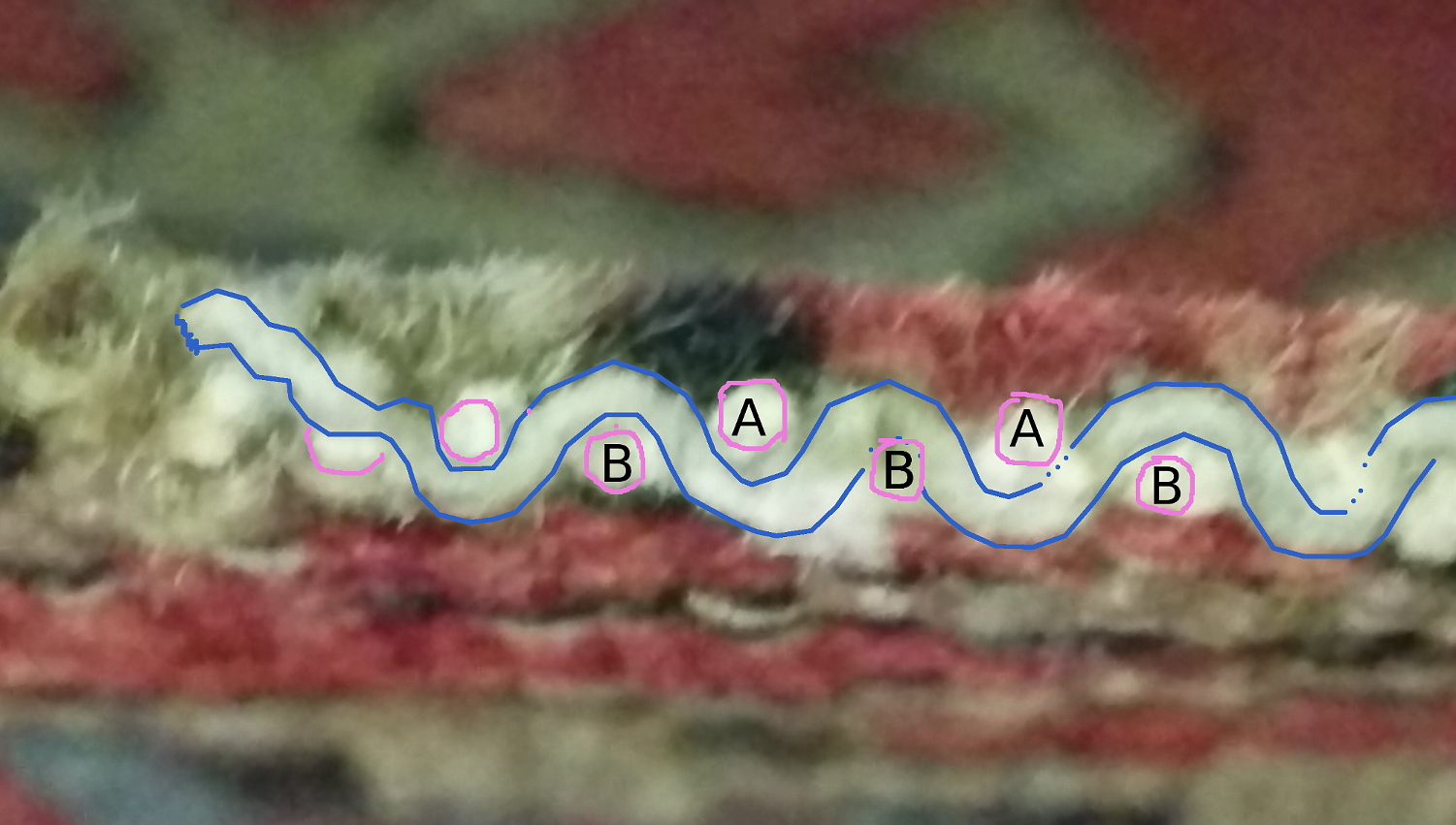Baghlani rugs, Turkmen rugs from north eastern Afghanistan originated in the late 1980’s and were woven through the mid 1990’s. Generally, Baghlani rugs are long and narrow, so this rugs squarish proportions are unusual. This example features blue, orange and marroon patterns with boats, jets and tanks balanced with flowers and rifles. The border is made up of multiple geometric guard stripes. This color scheme, and the Rows of Weapons design are emblematic of the Baghlani type.

UXO Rug, Life Sized Bombs
The other Terkmen and Uzbek War Rug With Light Fields is also made of the highest quality material and spired by other UXO, a.k.a. Unexploded Ordnance, rugs like the Weapon Inventory rug which is made from undyed wool and is visually appealing.
Here is a side by side.
1980’s Poppy Design Ali Kwaja with Airplane Guard Stripes Price on request
The contrasting blue skirt of this 1980’s rug offsets the mostly red color design which draws inspiration from Ali Kwaja which means, roughly, gentleman. Extensive research suggests Ali Kwaja rugs are Beshir Turkmen. Supposedly, they moved across the border into Afghanistan after the Bolshevik revolution consumed the USSR. This one is for sale.
Possibly, this rug was intended as a prayer rug, for notice the top two panels are separated from the lower panels by a white border stripe. The lower two panels are separated by an airplane border.
Pomegranates are a classic image in Afghan rugs. In pre-Islamic Persia and Afghanistan, pomegranate represented the soul to Zoroastrians. The Quran says pomegranates will be found in Paradise.
UXO Rugs Woven in Afghanistan
The UXO, a.k.a. Unexploded Ordnance, rugs were all woven in Afghanistan between 2002 and August 2021 and given the sanctions / embargo, there will be no more for the foreseeable future
They are inspired by older UXO rugs like the UXO warning rug and the Weapon Inventory War Rug. The new UXO rugs came in two sizes (5×8 feet or 1.5M x 2.5M and 6’6″x12’6″ or 2x4M) and made out of the “Chobi” wool is high quality wool, minimally processed then spun by hand.
The rugs feaature life sized UXO.
UXO Rugs
Unexploded Ordnance, a.k.a. UXO, Rug . Between 2002 and August 2021 these UXO rugs have been woven in Afghanistan and will be the last for the foreseeable future. They are life sized images and for sale in these sizes 5×8 feet or 1.5M x 2.5M and 6’6″x12’6″ or 2x4M here
UXO Rugs, a.k.a Unexploded Ordnance
UXO stands for Unexploded Ordnance there are a number of examples on the site some older like the Unexploded Ordinance Warning Rug and some which are still for sale and newer. Check out the Turkmen and Uzbek War Rug with Light Fields.
Sometimes these rugs come with a message like the UXO warning rug which says “do not touch or play with, these are very dangerous” in both Farsi and Pashto, the “unexploded” element creating a lasting impression of suspense.
The Turkmen and Uzbek UXO rug is done in the “Chobi” or “Vegetal Dye Peshawar” style with Turkmen borders. It is exceptionally beautiful.
Warp Depression a.k.a. “Double Knotted” rugs
The most confounding concept in rugs is “warp depression”, so I created a structures page with a bunch of annotated photos to explain it and give suggestions.
Before a rug is woven the warps are strung on the loom, and the warps can be made to lay in one plane, side by side. But warps can also sit on two planes where they alternate. Here is a rough diagram.
This post began in 2017 when I saw this cut rug revealing warps on two planes.

Here are some examples:
No warp depression:
Rug 779 Herat Friday Mosque with Armored Column
Minimal warp depression, offset by 20-30 degrees:
Rug #464 Bright Color Landscape Rug
Moderate warp depression, offset by 45-60 degrees, corduroy texture
Rug #925 Baleschet Saddle Bag with Motorcycle
Also, medium warp depression, offset by 45-60 degrees, with pronounced corduroy texture
Rug #1614 Classic White Background Amman Ullah Khan Rug
Full warp depression, a.k.a. “double knotted”, where the second warp is buried in the rug’s foundation:
Rug #1105: B-52 Medallions with Cluster Bombs and MRE’s
If this post clarifies warp depression, or if it just raises more questions, please let me know.
19th Century Daghestani Prayer Rug for Sale
This is not the focus of Warrug.com, but twenty years ago we picked up this rug, and now it is time to downsize.
The details are in the link: Rug #2122, Antique Daghestan Prayer Rug. The price is $3,500, so contact us if you are interested in purchase, and we will send a PayPal invoice.
The design of this rug is not typical of the type, and the pattern conveys a special sensibility. The figure, represented by the pattern inside the mihrab, is the same as the world, represented by the same lattice pattern outside the mihrab. The part that is different is where the prayers go up from the figure, and the lattice breaks down to series of small dreamy motifs.
Horace and Reed Anderson Film about the Ukraine War
Luca Emilio Brancati’s uniquely important collection
My understanding is that Luca Emilio Brancati collected war rugs from 1984 until 1987 exclusively. Thanks to Nigel Lendon, I saw a few photos over the years, but documentation of Brancati’s important 2018 exhibition at the gallery in the Palazzo Lascaris in Turin, Italy, was the first time good photos were published on the internet.




More rare photos are here, and on this FB post, and press coverage is here, and an announcement is here.
Brancati’s pinterest has lots of interesting war rug photos.
In Brancati’s new book with Amedeo Vittorio Bedini the photos alone are surely worth the thirty-four Euros.
Brancati’s last book was also a fascinating subject. Published in 1999 it seems to be out of print, but The Carpets of the Painters (or I Tappeti dei Pittori), analyzes rugs shown in old paintings.
